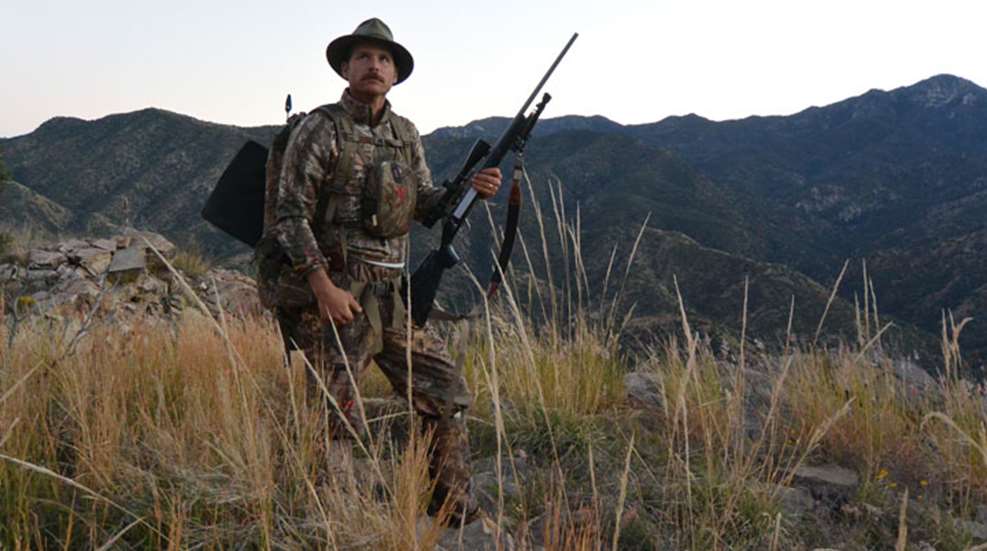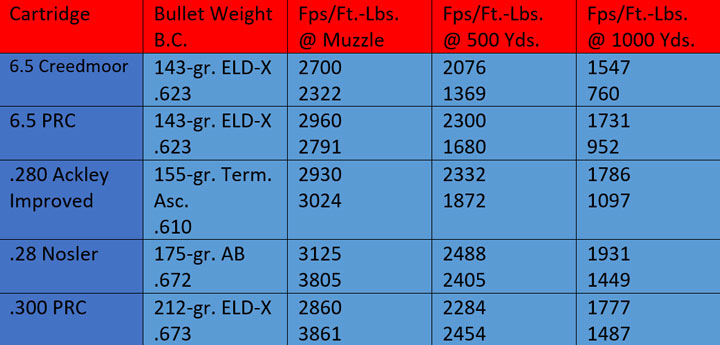
When I was a kid, the .30-06 Springfield and .270 Winchester were the most popular hunting cartridges on the market. Three hundred yards was a long-range shot, and laser rangefinders were unheard of. Some hunters still used iron sights, and a dial-up scope might have been one that you ordered via a rotary telephone.
Now, hunting is still hunting, shooting is still shooting, and the bugle of a bull elk is still an exhilarating sound on a crisp fall morning. But those basics aside, much has changed. The .30-06 Sprg. and .270 Win. have conceded popularity to the 6.5 Creedmoor and .28 Nosler, 600 yards is the new 300, and every hunter carries a rangefinder—especially when hunting the vast, open expanses of the West.
During the past two decades, cartridge design has jumped the corral bars and ran free with the mustangs. Hunters are shooting farther, hitting harder and absorbing less recoil than ever before. Grand old cartridges like the .30-06 Sprg. and the .270 Win. still kill game just as well as they ever have, but many of the new cartridges out-perform them, especially at extended ranges. Here are some reasons why.
Better Bullets
Projectile design and manufacturing processes have improved. Manufacturers are producing bullets that are more accurate, more consistent, more aerodynamic and perform superbly upon impact at a wide range of velocities.

Faster Twist Rate
Most of the new cartridges are designed to shoot long, heavy-for-caliber bullets. Long bullets must be shot through fast-twist barrels that spin them faster during flight, or they don’t stabilize. Twist rates of one turn in ten inches (1:10”) or 1:12” used to be common, but most of the high-performance cartridges of today utilize a twist rate in the 1:8” range.
Improved Cartridge Design
Simply put, reduced body taper, steeper shoulders and other shape changes have rendered today’s cartridges more efficient and more accurate.

Rising Stars of the New Millennium:
6.5 Creedmoor
Three hundred and eighty-six yards distant, a big mule deer buck rubbed his antlers in an overhanging tree branch. My 12-year-old daughter lay prone atop a sandrock outcropping behind her superbly accurate 6.5 Creedmoor rifle, the scope dialed to compensate for the distance. One perfectly placed shot later, the buck lay still among the sage brush. I was one ecstatic papa, and I’ve been sold on the Creedmoor as an ideal cartridge for young shooters, ladies and recoil-sensitive shooters ever since. My daughter has since killed numerous elk and deer with that same rifle, including an absolute monster of a muley buck last fall.


The 6.5 Creedmoor is the 2007 brainchild of Hornady’s engineers, and has become the “.30-06 Sprg. of the 21st century.” Meaning it is, and will likely remain, the most popular rifle cartridge of this century—and with good reason. Utilizing the .30 Thompson Center as its parent cartridge, the 6.5 Creedmoor sends a 6.5mm (.264-inch) diameter 143-grain projectile downrange at an average 2700 fps. That doesn’t sound like a lot, but when you add a BC (ballistic coefficient) of .623 to the equation it becomes significantly more impressive. Consider this: after starting out at 2700 fps, at 600 yards the Creedmoor still sports 2078 fps of velocity and 1,371 ft.-lbs. of energy.
A lot of shooters and hunters love to hate the 6.5 Creedmoor. To me that’s infantile. Sure, it doesn’t hit like a .300 Remington Ultra Magnum or scream downrange like a .22-250 Remington, but it is mild mannered, superbly accurate, and extremely lethal with proper shot placement. If you’re a younger shooter, a lady, or someone who simply wants a truly accurate cartridge with which to send a lot of lead downrange, the Creedmoor is your baby.

6.5 PRC
One of the most common complaints regarding the 6.5 Creedmoor is that it’s “anemic.” It’s not true—the CM is simply a moderate and very efficient cartridge. However, shooters and hunters wished for more horsepower under the hood of their 6.5s, and the 6.5 Precision Rifle Cartridge (PRC) is Hornady’s answer to that wish. Introduced in 2018 and boasting a 250 fps increase in velocity over the Creedmoor, the 6.5 PRC sends the same 143-grain projectile downrange at roughly 2960 fps. Based on the obscure .300 Ruger Compact Magnum, the 6.5 PRC is a short-fat cartridge, and functions admirably in short-action bolt guns. My only complaint with this design is that most magazines have only a three-down capacity.
Two years ago, when the cartridge was brand new, I made a trade for one of Gunwerks’ outstanding Clymr rifles chambered in it. Accuracy was fantastic, and my friends, family and I managed to harvest pronghorn, three mule deer and a big bull elk with it that fall. Every animal went down rapidly, and only one (a mule deer) required a coup de grâce.

In my opinion, the 6.5 PRC, out of all the 6.5 cartridges available today, will eventually triumph as the best 6.5mm hunting caliber. It’s very accurate, carries velocity and energy exceptionally well, and is mild-mannered to shoot. Many ammo and firearms manufacturers already offer ammunition and rifles in 6.5 PRC, even though the cartridge is only 2.5 years old at the time of this writing. When used with a premium projectile like a Federal Premium Terminal Ascent or a Barnes LRX, it’s a great all-around choice for western big game, including elk.

.280 Ackley Improved
One of my favorite calibers, the .280 Ackley Improved is like a ’66 Fastback Mustang and a new Lamborghini Diablo rolled into one. It’s not a true 21st century cartridge, being originally developed by P.O. Ackley and used by handloaders as a wildcat cartridge for many decades. But in 2007 Nosler took the cartridge to SAAMI and it was standardized, qualifying it for inclusion in this article. P.O. Ackley’s case design was way ahead of its time; the cartridge is superbly efficient, very accurate, and—when loaded with high-BC bullets and sent from a fast-twist barrel—excels at long ranges. Performance skates at the heels of the well-known 7mm Remington Magnum, sending same-weight bullets nearly as fast with significantly less propellant. Recoil is milder than the 7mm, and barrel life longer. Projectile diameter is .284 inches, the same as the 7mm Rem., as well as the .28 Nosler listed below.

The .280 Ackley Improved is based on the .280 Remington, and in fact .280 Rem. ammunition can safely be fired from your .280 AI rifle. Both are descendants of the .30-06 Sprg. family of cartridges. Most .280 Ackley Improved rifles will hold five cartridges in the magazine. Commercial ammo is currently available from Nosler, Hornady and Federal, and rifles chambered in .280 Ackley Improved are available from Nosler, Kimber, Savage and others.
I’ve personally harvested mule deer, elk, African plains game, and a very big, very old, wild maverick Arizona bull with my .280 Ackley Improved rifles. The cartridge is accurate, friendly to shoot and hits with confident authority. Most of the animals I’ve shot (including the wild bull) have been with Federal’s 155-grain Terminal Ascent bullet, and have been one-shot kills.
The .280 Ackley Improved is, to my way of thinking, the ideal western big game cartridge.

.28 Nosler
Here’s a cartridge I don’t have much personal experience with. I’ve shot it, and I’ve witnessed a handful of game harvested with it, including some African game, but never killed anything with it myself. What I’ve seen has impressed me, and all my long-range shooting buddies have convinced me that the .28 Nosler is nothing short of a fire-breathing dragon. Ballistic data corroborates that opinion. The cartridge made its debut in 2015.

Based on the .300 RUM cartridge, the .28 Nosler boasts velocity to spare. When coupled with long, high-BC projectiles it is indeed a marvelous long-range caliber. Recoil is a bit fierce by today’s shooter’s standards, and usually a muzzle break or suppressor is employed to tame it. But if you’re the guy who wants a rifle capable of shooting accurately into the next zip code and worthy to hunt anything on the North American continent, take a look at the .28 Nosler.

.300 PRC
The last cartridge on my list of Star cartridges of the 21st century, the .300 PRC, is candidly here for two reasons. First, a ton of rifle manufacturers had added the cartridge to their lineup when I cruised the floors at the 2020 SHOT Show, demonstrating public acceptance and popularity of the cartridge just over a year after its debut. Second, certain branches of the U.S. military have adopted the cartridge as their primary long-range (read sniper) round. That speaks volumes about the cartridge’s ability.
As you’ve probably guessed, I don’t have much experience with the .300 PRC. You’ve probably also surmised that it’s the big brother to the 6.5 PRC, and was designed by the engineers at Hornady. You’re correct on all accounts. A .375 Ruger necked down to .308 caliber, the .300 PRC is truly designed for extreme long ranges. Loaded with very heavy, exceptionally aerodynamic bullets, the .300 PRC is suitable for hunting almost anything, anywhere. It does require a full-length, magnum-sized action, and will recoil with authority unless tamed with a muzzle brake or suppressor. If you want to shoot brown bears in Alaska, bison in the Dakotas, elk in Montana, and ring steel at 2,000 yards, the .300 PRC should be next on your investment list.



































